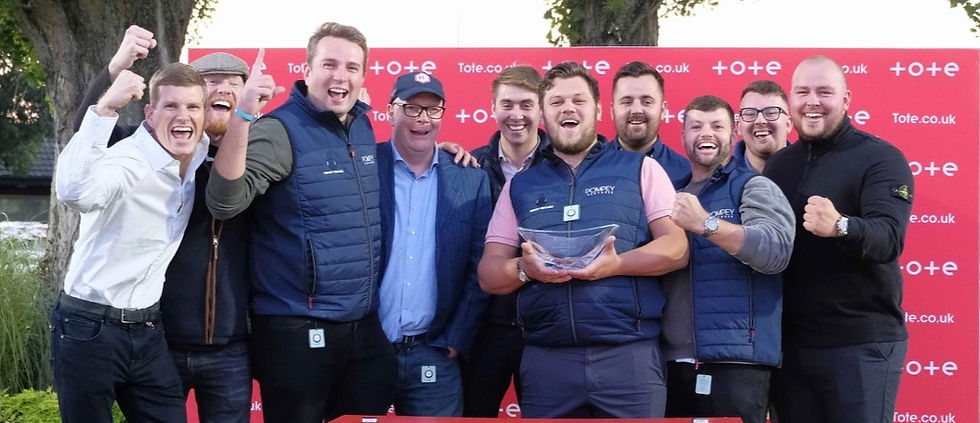How to Find a Winner in Horse Racing: The Novice Racehorse Owners Betting Guide by Pompey Ventures Winning Racehorse Syndicate
- PV Team

- Apr 11
- 7 min read
"Betting within your means is key, and so is smart ownership. Joining a winning racehorse syndicate, like those offered by Pompey Ventures, lets you enjoy racehorse ownership at a fraction of the cost, leaving you room to place informed bets without financial strain 😉"

Horse racing isn’t just about luck - it’s about reading the form, understanding the conditions, and making informed judgments. If you're tired of throwing darts in the dark and want to start identifying real winning opportunities, this guide is for you. Let’s break down the key factors that will help you find a winner.
1. The Draw: Position Matters
The “draw” refers to the horse’s starting stall in flat races. Depending on the track layout, certain
stalls can give a significant advantage. For example:
Tight, turning tracks like Chester in the UK heavily favor low draws.
Straight courses like the Rowley Mile at Newmarket and the straight course at Ascot,
the advantage can shift depending on the ground bias. Follow where the winners have
been drawn and if certain parts of the track are faster than others, on the day look for on
the day race patterns, always watch races and look where the winning horses race and
where they were drawn. If you see the 1st, 2nd and 3rd were drawn in stall 3, 1 and 2
that is relevant.
Crowded up: some horses can over-race when racing inside other horses and perform
better with space or being drawn outside others.
Intent barriers can also influence how a jockey may ride a race or the instruction he is
given from a trainer. Look for patterns that become predictable with both, and importantly
when coupled together. IE jockey X riding for trainer Y from a wide barrier at
Wolverhampton, expect intent early and roll forward. This is also very important in
jurisdictions like Hong Kong where certain trainers will always drop in from a wide draw.
Tip: Research past races over the same distance and track to see if a draw bias exists.
A useful tool to use is the ‘Draw’ feature on At The Races website which will show the
statistics and expected wins from each stall. Be careful to ensure your data is clean and
relevant - research things like track renovations or anything that would muddy your data
set. This is particularly important in Australia and New Zealand where track patterns
change from meeting to meeting
2. Ground Conditions (Going)
The “going” describes the condition of the turf or dirt. Horses can be very ground-dependent,
meaning they perform better on certain types:
Soft/Heavy Ground: Suits strong, stamina-laden types. Look out for horses with a big
rounded knee action that will get their toe in the ground to gain as much traction as possible. (Knee curl/ high knee action/pound the ground)
Good/Firm Ground: Favors speedier, lighter-framed horses with a low knee action that
can skip along the surface. (Daisy cutter)
Tip: Check each horse’s form for previous performances on similar ground. A quick look at the
pedigree will also help. Some stallions' progeny do particularly well on certain ground e.g. Lope
De Vega produces horses that go very well on soft ground. There are plenty of stallion patterns
and trends. There is also a lot of noise, watch enough racing and you will start to see the patterns like Raymond Babbitt in Rain Man, you must be more Raymond than this Will-not-get-beaten.
3. The Trip: Finding the Ideal Distance
The “trip” is the race distance, and not all horses stay the same trip equally well. A horse that
finishes strongly over 1m may thrive over 1m2f, but struggle over 7f.
Look for:
Evidence of staying power (strong finishes).
Pedigree hints (more on this below).
Trainer intentions (first-time try over a new distance can be revealing). Sir Mark Prescott,
look at the pedigree, look at the distances and pay attention to his unique training style.
If you crack his particular code you may be able to heat your beans on toast.
Jockey bookings and gear applied - blinkers off may be a sign that they want the horse
to settle to ensure it stays the trip.
Weight plays its part as well and often a horse will relish the distance step when aided by
an apprentice claim (see below point 6). Horses that lead can be very effective with an
apprentice on.
4. Pedigree: Bloodlines Tell a Story
A horse’s breeding gives vital clues about its potential:
Sprinter pedigrees usually point to earlier 2yo speed. Expect these horses to run over
5f, 6f and 7f.
Middle-distance or staying pedigrees suggest stamina and development with age.
Tip: Pay attention to sires and dams that have produced winners at similar trips, going, and
class levels. Some bloodlines are particularly suited to specific conditions (e.g., Galileo for
middle-distance/stamina on turf). Also keep an eye on trainers who are specialists at having
their horses run early and be cautious of those that let them develop for a longer trip. Dam sire
can be golden, when you see horses by mares that typically get a trip and they are first time
over 10f, 12f or beyond this can pay dividends.
5. Trainer Statistics: Trends and Form
Some trainers are masters at placing horses to win:
Hot trainers: Look at strike rates in the last 14-30 days.
Course specialists: Some trainers do consistently well at specific tracks.
Target trainers: Aiden O’Brien with Group races or Richard Hannon in a 2yo sales race,
for example.
Tip: Also note trainer-jockey combinations - some partnerships are extremely profitable
i.e. George & Billy
6. Jockey Stats: The Pilot Counts
A top jockey can make the difference in a close finish. Look at:
Strike rate: How often they win.
Recent form: Jockeys are like all other athletes, confidence and flow-states can impact
performance. Watch for indicators such as how many winners in last 5,10 and 25 rides
Track record: Some riders just ‘get’ certain courses.
Experience with the horse: Has this jockey ridden the horse before? Success tends to
come from familiar pairings. 2nd time a jockey rides a horse can be a positive factor,
keep an eye on this familiarity.
Tip: Watch for claiming jockeys (apprentices) with good records—they offer a weight
allowance which can still be highly effective. However, do your research on these claiming
jockeys and watch replays of their riding style as some are better than others.
7. Class Drops and Ratings
A horse dropping in class (e.g., from Group company to Listed, or from Class 3 to Class 5) can
have a massive edge. Likewise, a horse running off a falling handicap mark may now be
weighted to win.
Tip: Use official ratings and recent form to spot when a horse has the potential to “well in.”
8. Market Moves: Smart Money Speaks
Late money (especially 5 minutes before the race) can be revealing. If a horse shortens
significantly in price without obvious form, it may be a stable fancy.
Tip: Be cautious, market hype isn’t a guarantee, but it often reflects confidence. At the very
least, a market move that you didn’t expect should encourage you to understand ‘why’ and see
if you have missed something.
9. Headgear and Equipment Changes
When a trainer adds blinkers, cheekpieces, or a tongue-tie, it often means they’re trying to
unlock improvement. Watch for:
First-time headgear: A potential performance boost.
Return of headgear: If it worked before, it might work again.
Tip: Tread carefully - Headgear and equipment changes can often be a last ditched roll of the
dice for a horse that is underperforming or not showing the trainer much in its work. They are
not always positive signals.
10. Visual Clues: Watch Replays
Sometimes, the form doesn’t tell the whole story. A horse may have been blocked in, started
slowly, or was never asked for full effort. Watching replays can reveal hidden value. This is a big
indicator and one will develop this skill with the more races they watch.
Tip: Spend as much time watching the first half of a replay as you do the last half. Everyone
remembers the horse held up at the furlong pole and this is often reflected in the market price or
over bet. Go hunting for gold and factors that occur early in a race when doing a review.
Putting It All Together
Picking a winning racehorse is about weighing all these factors, not relying on just one. A horse with:
A good draw
Proven form or predicted to handle the going
Ideal trip and solid pedigree
A trainer in form
A confident jockey booking
Good recent runs (watch replays)
And subtle market support
Price is life, ask yourself is this value. If it feels too short, sit it out
Be patient as WB the oracle famously said: “Wait for the pitch. The money is made in the
waiting”
Algo’s will beat you long term, less is more
If you are fed up with not getting on, move to Australia where gambling is encouraged
and not frowned upon, plus the weather is better
Crucially, always bet within your means
Final Thoughts: Think Like a Detective
The best punters treat horse racing like a puzzle. Each race is a mystery, and the clues are
there - draw, ground, trip, pedigree, trainer, jockey, and more. The more informed your bet, the
less it relies on luck.
Don’t just chase favourites. Find the angles others miss. That’s where the value lies and where
winners come from.
Happy punting and may your next selection bolt up!
The Pompey Ventures Team💙🖤
"Start small, bet smart, and enjoy the thrill of the track!”
Ready to take your racing passion further? Joining a winning racehorse syndicate with Pompey Ventures lets you own a share of a racehorse, giving you a personal stake in races and the chance to apply these betting tips with insider knowledge😉

Now you know how to pick a winning racehorse...
Why not take it one step further and pick a winning racehorse syndicate? 😉

Experience the thrill of ownership with Pompey Ventures Winning Racehorse Syndicates!










